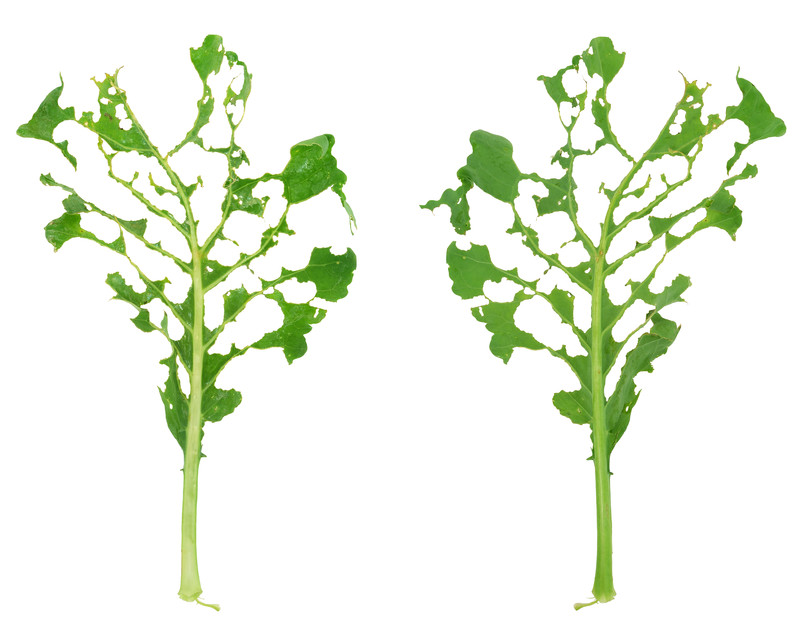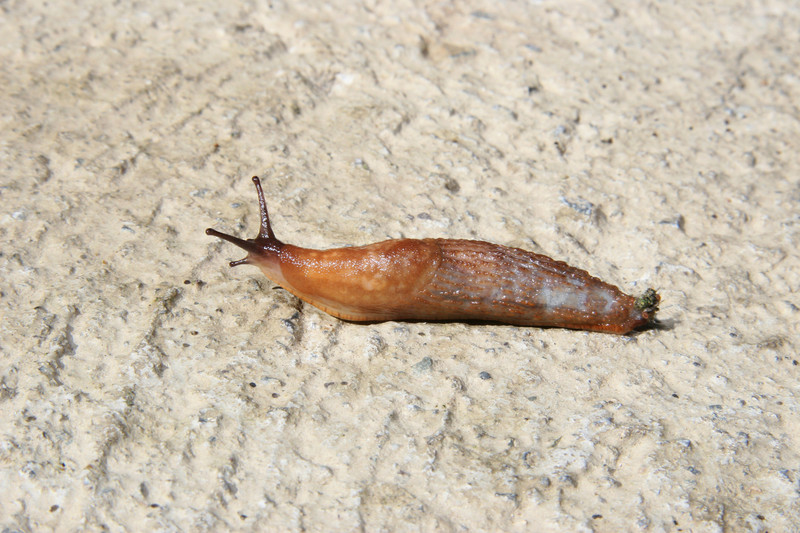Slugs and snails are soft-bodied wormlike animals, members of the mollusk zoological group. Snails have coiled shells. Slugs have no shells.
Slugs and snails chew irregular holes with smooth edges in leaves, stems, and ripening fruits of vegetables and other succulent plants. Control slugs and snails by handpicking, traps, and barriers.
Good Products for Pest and Disease Control at Amazon:
- Garden Safe Snail and Slug Bait
- Bonide Sulfur Fungicide
- Monterey BT Caterpillar Killer
- Neem Bliss 100-% Cold Pressed Neem Oil
- Safer Brand Insect Killing Soap
- PyGanic Botanical Insecticide
Slugs and snails can be as small as 1/8 inch to as large as 8 inches long. They can be gray, tan, green, black, yellow, or spotted. The presence of snails and slugs is betrayed by the secretion of a slimy mucus on which they glide along leaving a shiny trail.

Slugs and snails feed at night and on overcast days. They go undercover when the sun shines. Slugs and some snails can burrow into the soil while other types of snails hide in debris or on plants. If conditions are too dry, a snail can seal itself in its shell and remain dormant for up to 4 years.
Scientific name: Phyllum: Mollusca.
Slug and snail lifecycle
Slugs and snails are grayish or brownish worm-like mollusks 1 to 2 inches long with legless bodies. Snails have spiral shells; slugs do not. Females lay white eggs encased in slime buried in the soil. Young slugs and snails look like their parents only smaller.
Every slug and snail has both male and female sex organs so any individual can lay clusters of tiny gelatinous eggs in the soil. Some can fertilize their own eggs. Adults lay eggs in moist soil or under rocks or garden debris. The eggs hatch in 2 to 4 weeks and young grow five months to two years before reaching maturity.
Snails and slugs and their eggs can overwinter. The adults emerge in early spring and are active until the summer weather gets dry and hot—then they burrow or hide where it is cool. They emerge again in the fall when the weather turns cool.

Slug damage to kohlrabi leaves
Target plants
Almost all plants, especially young seedlings, leafy crops, beans, tomato fruits, and strawberry fruits.
Feeding habits and damage
Snails and slugs rasp large ragged holes in foliage, stems, fruits, and bulbs. They can eat seedlings whole. They eat tender plants and shrubs.
Slugs and snails chew irregular holes with smooth edges in leaves, stems, and ripening fruits of vegetables and other succulent plants. Control slugs and snails by handpicking, traps, and barriers.
Concentrate your slug and snail control efforts early in the garden season as the weather begins to warm and these pests begin to feed and reproduce. Follow up regularly to eliminate those undetected or newly hatched.

Organic controls
Handpick slugs and snails when they emerge in the evening. Place shallow saucers of stale beer in the garden to attract and drown slugs and snails. Dust with diatomaceous earth around target plants—slugs and snails will be injured and die after crossing diatomaceous earth. Iron phosphate is an organic material that is toxic to slugs and snails. (Avoid baits that contain metaldehyde which is toxic to people and animals.)
Hand-picking
Handpick snails and slugs by flashlight at night when they are most active. Drop them into a can or bucket of soapy water where they will drown or kill them by sprinkling table salt on them or crushing them. In the vegetable garden, search for slugs and snails near and on leafy crops and also on and around maturing fruiting crops such as strawberries and tomatoes.
Like other mollusks, snails, and slugs need to be moist at all times. During the day, they retreat to cool, damp, dark hiding places—under low-growing plants or under boards or flower pots. At night they move about freely to feed–even crossing sidewalks and driveways. They are most active beginning about two hours after sunset until about two hours before sunrise. This is when searching out and handpicking slugs and snails is the most effective.
Look for slugs and snails around the stems of plants and also under leaves well up into the plant. The slimy mucus slugs and snails secrete to move over dry surfaces also acts as an adhesive which allows them to move upside down on plant stems and leaves. The mucus also can act as a thread which will allow slugs to lower themselves from one leaf or branch to another as they feed.
In cold weather, search for slugs near the crown of perennial plants where they burrow under to feed on roots. Snails set a hard, transparent film across their shell opening during cold weather and will shelter under boards and plants.
Trapping
To trap and handpick snails and slugs during the day, place a wide board, a shingle, or an upturned flower pot alongside plants that need protection. The pests congregate in dark, damp places where the soil is moist and or where there is damp mulch or acidic organic material. (They cannot tolerate dry weather or dry or alkaline soil.) Each morning turn over the cover and collect and crush the pests or kill them with a spray solution of 1:1 household ammonia and water.
Drowning
Drown slugs and snails by placing a shallow pan or tin can with the lip just below soil level filled with beer or 1 teaspoon of baking yeast in 3 ounces of water near plants where the pests feed. Slugs and snails are attracted to the yeast; when they come to drink, they fall in and drown.
Barriers
Snail and slug bodies are soft and sensitive to sharp objects. Sprinkle diatomaceous earth (ground up, powdery prehistoric shellfish), wood ashes, or fine sand around plants you want to protect. The sharp, gritty edges will deter these soft-bodied pests; they are unable to exude enough slime to get over gritty or sharp edges. Once these barriers become wet with rain or irrigation, snails and slugs cab slide across them on a film of water. Dry chaff and straw and wilted vegetation spread around vegetables seedlings or plants also will act as a barrier.
Copper barriers
Strips of copper at least 2 inches wide can be used as a barrier along the edges of raised beds. Copper reacts electrochemically to the slug and snail slime and deters the pests from crossing over. Install copper strips in dry weather. Be sure to eliminate snails and slugs trapped inside the barrier because they can’t get out either.
Soil additives
Mix coarse river sand into humus-rich garden soil; soil that is rich in acidic organic materials attracts snails and slugs but the pests will be deterred or fatally injured by the sharp edges of sand. You can also add worm castings (excrement) to your garden soil. Castings are nutrient-rich and also alkaline; slugs and snails are deterred by the alkaline.
Organic control calendar
Here is what you can do seasonally to control slugs and snails:
- Before planting: Remove any surface mulch, loose wood, or debris under which snails and slugs can harbor during the day. Put drip irrigation in place or plan to hand water to keep the soil mostly dry.
- At planting time: Place repellent barriers around planting beds—diatomaceous earth, crushed eggshells, pine needles, wood ash, dry sand, and lime. Set a copper barrier in place around planting beds.
- While crops develop: Overlaid flower pots grapefruit halves and boards laid on the ground make good traps. Wrap copper strips around the stems of plants and use copper flashing at the edge of garden beds. Attract slugs and snails with raw cabbage leaves then collect and destroy them in the early morning. Trap in shallow pans of beer buried to the lip of the container in soil. Protect seedlings with wide bands of wood ashes or diatomaceous earth.
- After harvest: Clean the garden of all garden debris under which snails and slugs can harbor during the winter.
Natural predators
Animal predators include downy woodpeckers, robins, and other garden birds. Other animal predators are garter snakes, salamanders, toads, turtles, chickens, and ducks. Insect predators include black rove beetles, centipedes, firefly larvae, ground beetles, and soldier battles. Slugs are a favorite food of snakes and toads (which can eat three times their weight in slugs in a day) and also fireflies.
Related articles:
Vegetable Garden Organic Pest Control
Vegetable Garden Diseases Problem Solver
Vegetable Garden Organic Weed Control
Garden Planning Books at Amazon:
- Vegetable Garden Almanac & Planner
- Kitchen Garden Grower’s Guide Vegetable Encyclopedia
- Vegetable Garden Grower’s Guide
- Tomato Grower’s Answer Book



